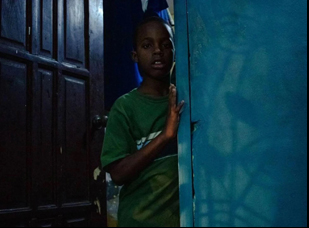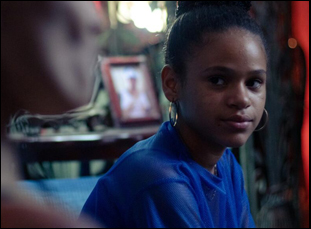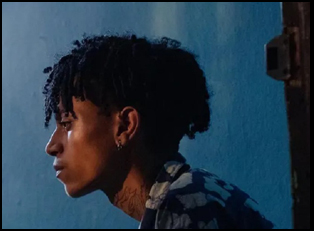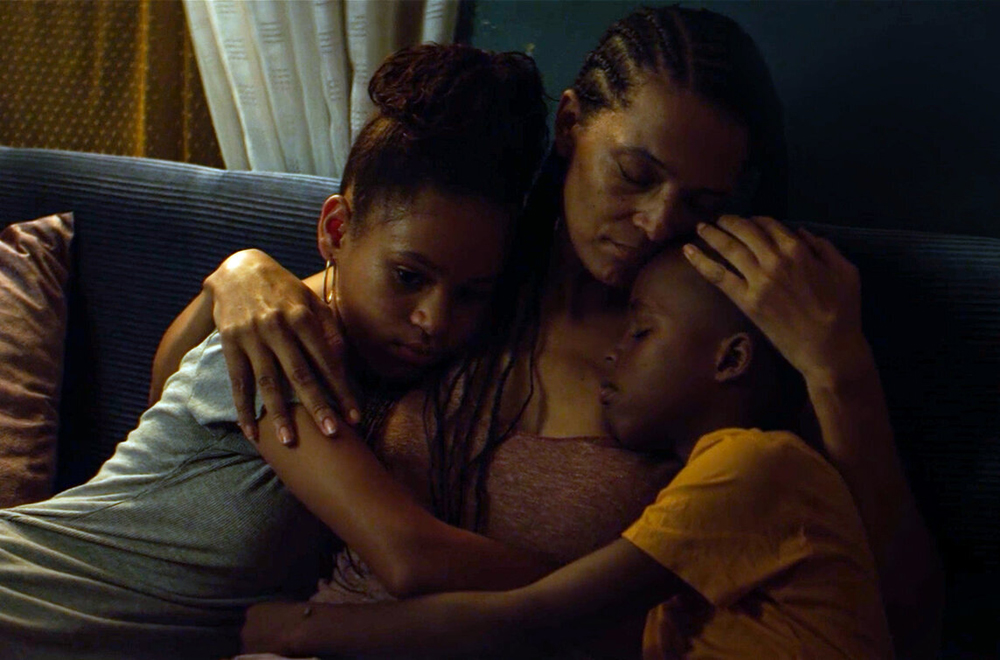When Clarisse Albrecht and Ivan Herrera collaborate on something together, their friends and colleagues know just where they’ll be, to the point that they’ll refer to any joint projects as “Under the Mango Tree.”
“This is how we like to call ourselves when we write together because we literally write under a mango tree in the garden,” says Albrecht of finding a screenwriters’ haven like no other in the Dominican Republic. “Yeah, we make juice [too], but sometimes it’s dangerous.”
“It’s crazy,” says Herrera, noting the occasional workplace hazard. “Sometimes the mangoes fall and it’s like wait, bang!”
“Ow, my computer,” Albrecht laughs.
However, this isn’t all that much an inconvenience when two would seem to welcome any opportunity to add flavor to their films, even if it poses the threat of a bump on the head, and in fact, it likely contributes to why such sweetness emerges from “Bantú Mama,” which the partners, both professionally and personally, co-wrote for Herrera to direct and Albrecht to star in. Bearing traces of their own cultural roots, the film illuminates the beauty of people of different backgrounds meshing as a family when Emma (Albrecht), a woman of French-African origins is lured to the DR with the promise of easy money, smuggling bags that she doesn’t know what’s inside. But when a transport goes bad, there is an even greater surprise awaiting her when she is found clinging to life in the ocean by a trio of kids (Euris Javier, Arturo Perez and Scarlet Reyes) who can relate to being adrift when their father was locked up and their mother died, leaving them to fend for themselves.
While Emma can’t leave the house for fear of being found out, she starts to make a home for the kids back in their small abode, sharing the food she learned to cook from her own mother and other traditions that provide some comfort to all of them, even though for Emma, there’s also a slight sense of unease when she yearns to know more about her ancestral home of Senegal. Even if “Bantú Mama” is light on its toes as a narrative, a fleet-footed drama as energetic as its youthful cast awash in the bold colors of its setting, it carries the weight of history that its characters are conscious of without necessarily being fully cognizant of it, knowing there’s a piece of themselves that they’ll spend the rest of their lives trying to understand and finding in one another a way to fill the void. The film, which premiered at SXSW last year, has been picking up admirers around the world ever since, including the fine folks at ARRAY who recently set up a release at Netflix with the film in Oscar contention as the official selection of the Dominican Republic.
Recently Albrecht and Herrera made the trip to Los Angeles to talk about how they wanted to shine a light on a side of their home county that few outside of it often get to see, capturing the vibrant energy of the neighborhood they were filming in and how they pieced the film together during the pandemic to become a hit with audiences once the world started opening up again.

Ivan Herrera: I grew up surfing in a neighborhood that was [similar to the] life as Capotillo because it was a neighborhood away from the center of the city of Santo Domingo where you have many realities happening at the same time. When I started to explore the urban music world in the Dominican Republic, I started to go to these places. Capotillo was one of those neighborhoods that you knew was very violent at times and very poor, but at the same time, you’d find the nicest people, the people that would take care of you like you were family, and I I wanted to tell their stories I felt the media only portrayed the wrong side of the neighborhood. By going to Capotillo, we had the opportunity to focus on a different side of what everybody’s used to seeing and we tried to portray them with dignity and seeing only the beauty of it.
Clarisse, I imagine you were immersed in Capotillo already, but did this put you in touch in a greater way with the Dominican Republic?
Clarisse Albrecht: Well, I’ve been living in the Dominican Republic for many years now and I was already a bit familiar with this neighborhood. I come from the suburbs myself in Africa, so there’s a lot of codes that are very similar. Sometimes something that I thought was very Dominican, I was like, “Oh no, this is very universal” — food, folklore. and I understand this because my mother comes from this kind of same neighborhood in Cameroon, so we realized this is very universal. It’s not only one country, one barrio, one hood. There is something in common because we are humans living in similar conditions, so this is kind of normal and natural that we express it the same way.
I understand the headdress scene was actually inspired by Clarisse’s mother teaching Ivan how to wrap it…
Clarisse Albrecht: Yeah, we were in France, and we always hang around the African neighborhood in Paris. We wanted to bring a gift to Ivan’s mother and we bought a [headdress] and my mother explained to Ivan, “Look, you have to teach your mother the different ways she can wear it. It’s a different thing if she’s a businesswoman, she has to put it like that. If she doesn’t want to show that she’s working, she puts it like that.” Ivan loved that and we decided to put it in the film because it was really transmitting something about her African heritage and this was more than a piece of cloth that you put on your head. It has a bigger meaning.
Ivan Herrera: Being a Dominican and having Clarisse come into my life [as an] Afropean with her mother from Cameroon and her father from France, she taught me so many things that I just didn’t know that was the reason for certain things. It was a big [education] for me that it was not only a piece of clothing, but it has different meanings and this is a great example of how this Afropean character gets into this Afrocarribean house and how they merge by really talking about and passing on the traditions, so it was a beautiful scene to integrate into the film because it had so many meanings and the film is about opening this conversation and teaching in a very subtle way things that we might ignore in the Dominican Republic and probably so many other places that can identify with that.
Clarisse, I understand this might not have been something you thought of starring in, but how did you come to act in it?
Clarisse Albrecht: It comes from our previous experience as co-writers and co-producers. As an actress, I’ve never really [played] a main character and what we learned from our previous experience is it’s sometimes complicated to have an actress dedicated to the film [during the time it takes to set up a production], so maybe it should be me. [laughs] We would have all this freedom and maybe [Ivan and I] will have time to work more together, which we enjoy, so this is this was a production decision, but also a family position.

Ivan Herrera: We wanted to work with kids that were from this environment, so they knew the neighborhood and they know how it sounds, how it smells, and how fast it can go — it can change at any minute. An actor friend of ours, who was actually providing some acting classes [as part of] a cultural program of the government would go into these neighborhoods and we decided we’d go with him to see what kids were going into these classes and hopefully we could find some we could work with. That’s exactly what happened. We found Scarlett [Reyes], who plays Tina and Euris, who plays Kuki — they’re actually cousins, and we always [say] it was like love at first sight because of the spark [they had], but also because of the type of look that we exchanged. We were like, “We want to work with these kids” then I met Arturo [Perez, who plays Shulo] through a friend that works in the urban music industry in the Dominican Republic [who told me] this kid is always around the singers and the rappers, and he had a nice look and was very talented. I’m like, “I’m going to work with him,” and then we started to rehearse and prepare the film.
Are there things that get you excited when you start seeing the script come alive as they act it out?
Ivan Herrera: Yes, things get you excited, but also things like oh, it’s not that easy. [laughs] You need things to get done, but they need to get done in a proper way that makes sense in the film, and it’s not that easy to bring [the actors] to this amount of concentration over this amount of days and they have to have the right attitude at certain scenes. Of course, you don’t shoot [the film] chronologically, so you have to make them understand the experience, [which] is very hard, but there’s a lot of gratification too to see that we can make a great space to work and for them to grow.
It seems like the camera stays quite connected to the characters – is it intuitive at all once you get on set or is a lot of the camerawork planned out?
Ivan Herrera: It was planned out with our DP and our production designer, and we work with only one 16mm anamorphic lens the entire film, and we never used a tripod. The camera was handheld, but not very shaky, so it was just alive and breathing. We were shooting with mostly natural light and we were using the windows and reflectors. Of course, we wanted an aesthetic and a look to the film that was attached to the reality. These places sometimes, you get there and you see a house painted in blue totally and you have a chair that’s red in the corner and it’s just so natural that it’s there. It was not even designed or planned and we were just emulating that reality and these spaces become more warm. The house was very small and we didn’t want to fake it, like let’s shoot fake walls so we could have more space. No, if the space was small, we were going to make it feel like it’s small. So we attach ourselves to the reality and we focused on having a great environment for the camera to live, but also for the characters to have their space.
You also don’t fake the locations you shoot in, which must’ve been a tremendous challenge for a production of this scale to film in three different countries. What was it like to pull off?
Ivan Herrera: We knew that the character needed to come from Europe heading to the Caribbean and [they] needed to end up all the way back to the motherland, so we found ways to shoot with minimal crew in France, and then a little larger crew in the Dominican Republic where the biggest portion of the film was shot and then when we shot Senegal, it was again going back to a very small crew. I think it’s a lesson to aspiring filmmakers that there’s ways to do it — you don’t need a thousand people. You just need the key elements to shoot your scenes and it was a pleasure to work in these three countries in a different structure of a crew.
Was filming in Senegal actually last as it is in the story?
Clarisse Albrecht: Yeah, it was great that it was last. The emotion was definitely there, and it was like a dream for us as a couple, as filmmakers, as travelers. It was great that we did it at the end and two weeks after came back from Senegal, the world shut down, so we were like…
Ivan Herrera: Right on time. Yeah, we finished Senegal, got back home and the world just shut down.

Clarisse Albrecht: We put our head down first. [laughs]
Ivan Herrera: And then it was [how] can we continue? We have [the footage] on the hard drives and we can start editing remotely and that’s we did after a couple of months because at the beginning of the pandemic, it was very uncertain for everyone, but we sent over the hard drives to the editor in Santo Domingo, which is four hours away from where we live, and [he was editing] when he had the time because there was a curfew as well in the DR. No one was going to the office and even if they were going by themselves, they’d rather stay home, so when he was able to go back to the studio, he was going by himself with all the precautions and started to slowly put things together. The first cut of the film was done totally remotely.
I know it might’ve been a subdued premiere because SXSW wasn’t yet in person…
Ivan Herrera: It was still a big honor for us to be selected at SXSW, no matter if it was going to be by e-mail, and you could tell if they were going to put a virtual festival together, it was going to be a good one.
Clarisse Albrecht: And it was. The Q & A actually lasted longer because it was Zoom and people were not afraid to ask questions.
Ivan Herrera: You even have a virtual reception after the screening. We met a lot of people.
Clarisse Albrecht: Yeah, we discovered an application where we could have dinner together and we could have conversation. There was a nightclub, but we couldn’t get in. [laughs] Because the line was too long. The line was too long!
Just like in real life!
Clarisse Albrecht: It was a great experience. And it’s great to experience in-person screenings and see live reactions and share with the audience. We went to an African film festival in Colombia and it was an amazing, amazing screening. We learned a lot and the audience was really receptive to the film.
Ivan Herrera: Yeah, and now we’re super excited that it’s coming out to a wider audience that is Netflix, knowing that it can reach so many people who can watch the film.




